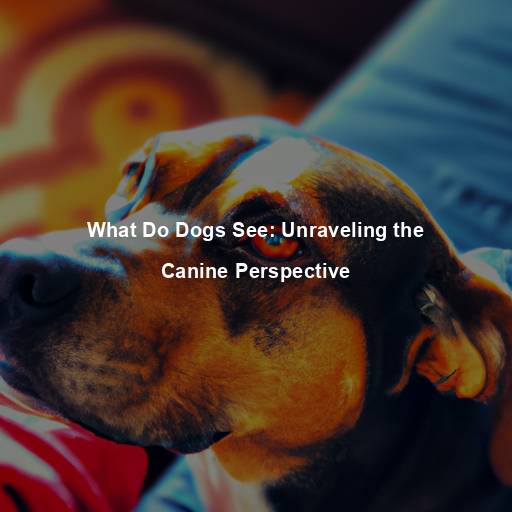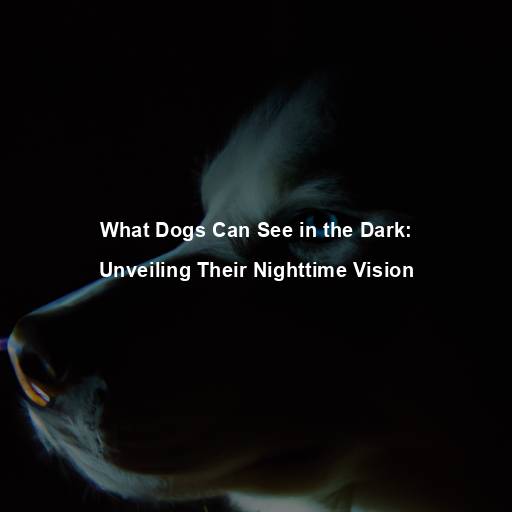What Do Dogs See: Unraveling the Canine Perspective
Last Updated on November 12, 2023 by Evan
Contents
- 1 : The Mysterious World of Canine Vision
- 2 Understanding Canine Visual Acuity
- 3 The World Through a Dog’s Nose
- 4 Canine Depth Perception: The Art of Judging Distance
- 5 Can Dogs See Themselves?
- 6 Can Dogs See Better Up Close or Far Away?
- 7 The Influence of Size and Shape on Canine Vision
- 8 Understanding Canine Perception: Beyond Sight
- 9 FAQs on What Do Dogs See:
- 9.1 What is the difference between how dogs see and how humans see?
- 9.2 Can dogs see colors?
- 9.3 Do dogs see in black and white?
- 9.4 How well do dogs see at night?
- 9.5 Can dogs see things that humans cannot?
- 9.6 Do dogs have better peripheral vision than humans?
- 9.7 Are dogs near-sighted or far-sighted?
- 9.8 How do dogs perceive mirrors?
: The Mysterious World of Canine Vision
Dogs have long been regarded as man’s best friend, but have you ever wondered how they perceive the world around them? While we humans experience the world through the lens of our own visual capabilities, our canine companions have a unique perspective shaped by their evolutionary history. In this article, we will embark on a fascinating journey into the realm of canine vision, seeking to unravel the mysteries and shed light on what dogs truly see.
Understanding Canine Visual Acuity
The Myth of Black and White
Contrary to popular belief, dogs do not see the world in black and white. While their color vision is not as rich as ours, they do possess a limited spectrum of hues. Scientific research suggests that dogs perceive colors in a more muted and diluted manner, with a preference for shades of blue and yellow. This unique color perception is a result of their visual receptors, known as cones, which are less sensitive to reds and greens.
The Power of Peripheral Vision
One of the most intriguing aspects of canine vision is their remarkable peripheral vision. Dogs possess a wider field of view compared to humans, allowing them to detect movement and objects in their surroundings more efficiently. This enhanced peripheral vision is a remnant of their ancestral instincts as predators, enabling them to spot potential prey or threats from afar.
Dim Light Vision: The Gift of Night Vision
Have you ever marveled at your dog’s ability to navigate effortlessly in low-light conditions? Dogs have a superior capability for night vision, thanks to a specialized structure called the tapetum lucidum. This reflective layer behind their retina enhances their sensitivity to dim light, enabling them to see more clearly in the dark. It’s no wonder they make excellent companions for nocturnal adventures!
The World Through a Dog’s Nose
A Scent-Oriented Universe
While our vision primarily shapes our perception of the world, dogs rely heavily on their sense of smell to navigate their surroundings. The olfactory system of dogs is truly remarkable, with a staggering 300 million scent receptors compared to our mere 6 million. This extraordinary sense of smell allows them to detect scents, trace trails, and even identify certain medical conditions in humans. For dogs, the world is a tapestry of scents waiting to be explored.
The Merging of Senses: Vision and Smell
Unlike humans, who primarily rely on vision, dogs expertly merge their sense of smell with their visual perception. This synesthetic experience provides them with a more holistic understanding of their environment. Imagine a world where the scent of a tree is as vivid as its visual appearance, or where the aroma of a loved one is intertwined with their physical presence. For dogs, this multisensory integration creates a tapestry of sensory information that we can only begin to imagine.
Canine Depth Perception: The Art of Judging Distance
The Science Behind Depth Perception
Depth perception is a crucial ability for humans, allowing us to gauge distances accurately. But how do dogs perceive depth? While their depth perception is not as refined as ours, dogs possess other visual cues to help them judge distances. They rely on motion parallax, which is the apparent displacement of objects due to movement, to understand the spatial relationships between objects.
The Challenges of Depth Perception
When it comes to our furry companions, it’s fascinating to observe how they navigate the world around them. While dogs may not possess the same level of precision in depth perception as humans, they have their own unique ways of tackling challenges. Catching a ball in mid-air or maneuvering through tight spaces may present difficulties for them, but their natural agility and clever problem-solving abilities never cease to amaze. It’s a delightful reminder of the resourcefulness our canine friends possess in the face of perplexing situations.
Can Dogs See Themselves?
The Mirror Test
Have you ever wondered if dogs can really see themselves in the mirror? It’s a curious question that has puzzled many pet owners. While dogs may show some sort of reaction when they see their reflection, it’s still debated whether they truly grasp the concept of self-awareness. It’s not that they lack intelligence or emotions, but rather that their perception of mirrors may be entirely different from ours.
The Emotional Connection
Doggos, bless their furry hearts, may not be experts in existential pondering, but oh boy, do they know a thing or two about unconditional love and emotional support! Their uncanny knack for picking up on our vibes and responding with heartfelt empathy is truly mind-boggling. Maybe they can’t quite grasp their reflection in the mirror, but when they gaze into our eyes, it’s like they’re peering into our souls, radiating pure adoration and unwavering devotion.
Can Dogs See Better in the Dark?
Dogs possess an intriguing and somewhat mystical talent for seeing in dimly lit environments. The question arises: do they surpass humans in their ability to navigate darkness? It is true that our canine companions possess an advantage in this realm, thanks to their remarkable night vision. However, it is worth noting that dogs still require a certain level of ambient light to effectively maneuver through their surroundings.
The Impact of Breed on Canine Vision
Just as humans have varying visual capabilities, different dog breeds may also have unique visual characteristics. For example, brachycephalic breeds with pushed-in faces, like Bulldogs and Pugs, may have more limited peripheral vision due to the shape of their skulls. On the other hand, sighthound breeds, such as Greyhounds and Salukis, are known for their exceptional visual acuity and tracking abilities. Understanding these breed-specific differences can help us tailor their environment and activities to ensure their visual needs are met.
Can Dogs Watch Television?
The captivating phenomenon of dogs appearing captivated by television programs has left many pet owners perplexed. As creatures with a distinct visual perception from humans, it remains uncertain whether dogs truly comprehend the happenings on the screen. The reaction to moving images on television can differ greatly among our canine companions, with some displaying curiosity while others seemingly unaffected. It is crucial to bear in mind that dogs primarily rely on their keen senses of smell and hearing to navigate their surroundings, making television a secondary source of stimulation.
Can Dogs See Better Up Close or Far Away?
Near Vision: The World of Sniffing
When it comes to the fascinating world of canine vision, dogs display a mesmerizing knack for honing in on scents rather than getting caught up in scrutinizing intricate details. Their olfactory senses, as we know, are astonishingly refined, which could make their direct visual acuity seem less dazzling by comparison. But let’s be clear, dogs aren’t oblivious to objects in close proximity; they have a commendable ability to perceive shapes and colors, even if their curiosity tends to veer towards scent-drenched expeditions and embracing the world through the whims of their sniffers.
Far Vision: Spotting the Prey
While dogs may not have the same level of visual acuity as humans when it comes to discerning fine details in the distance, they possess other visual abilities that aid them in their hunting instincts. Dogs have a keen sense of motion detection, allowing them to spot prey or potential threats from afar. Their peripheral vision and ability to detect subtle movements enable them to track and pursue objects in their surroundings with remarkable precision.
The Balance Between Near and Far
The captivating world of our canine companions never ceases to amaze. By delving deeper into the intricate web of their visual prowess, a fascinating tale unfolds. Dogs, in their enigmatic wisdom, have struck a unique accord between near and far vision, a delicate dance that leaves us in awe. While their sense of smell reigns supreme in the realm of close-quarters detection, their distant visual acuity may seem shrouded in mystery.
The Influence of Size and Shape on Canine Vision
The Size Factor
When it comes to visual perception, size really matters in the world of our furry friends. Take a walk with me through the fascinating realm of canine vision. We’ve discovered that bigger breeds reign supreme when it comes to expansive panoramas, thanks to the strategic placement and architecture of their eyes. However, don’t underestimate the little ones!
The Impact of Muzzles
The shape and length of a dog’s muzzle can also affect their visual perception. Dogs with longer muzzles, such as Greyhounds and Collies, typically have a wider field of vision compared to breeds with shorter muzzles, like Bulldogs and Pugs. The positioning of their eyes in relation to the shape of their muzzle can influence how much peripheral vision they have. It’s important to consider these factors when designing spaces or engaging in activities that involve a dog’s visual abilities.
Understanding Canine Perception: Beyond Sight
The Power of Hearing
In the fascinating realm of canine perception, it’s not just their sharp vision that captivates us, but also their extraordinary sense of hearing. Dogs possess an innate ability to pick up sounds that lie beyond the reach of our own ears, tapping into a hidden auditory dimension. Their ears, finely attuned to the intricacies of the sonic world, are like delicate receptors, constantly attuned to the ever-changing symphony of sounds that surrounds them. From the subtle whispers of leaves dancing in the wind to the distant melody of a doorbell, dogs unlock a tapestry of auditory cues that broaden their perspective of the world.
The Sixth Sense: Canine Intuition
Dogs, these magnificent creatures, possess an extraordinary array of senses that surpass our human limitations. Only canines can effortlessly tap into their inherent intuition to navigate the complexities of our world. Through their sharp vision and acute hearing, they detect the slightest cues, both seen and unseen, allowing them to grasp our emotions, intentions, and the intricate dynamics of their environment. This sixth sense, often hailed as doggy intuition, is a testament to the profound and unbreakable connection they forge with us humans.
FAQs on What Do Dogs See:
What is the difference between how dogs see and how humans see?
Dogs and humans have different visual abilities due to variations in their eye structures. Dogs have fewer color detecting cells (cones) in their retinas compared to humans, which means they see fewer color shades. They also have a higher number of motion detecting cells (rods), allowing them to perceive moving objects more clearly than stationary ones. Additionally, dogs have better night vision due to a reflective layer called the tapetum lucidum behind their retinas, which amplifies incoming light.
Can dogs see colors?
Yes, but with limitations. Dogs perceive colors differently than humans as they have a reduced range of color perception. While humans have three types of cones that detect red, green, and blue wavelengths, dogs have only two types, which detect yellow and blue wavelengths. As a result, dogs see the world in mainly shades of blue and yellow, with green appearing more like a yellowish color.
Do dogs see in black and white?
It’s time to debunk the myth that dogs see the world in black and white. While it’s true that our furry friends don’t experience the same vibrant colors as humans do, they do have some level of color vision. Think of it as if they have a touch of red-green colorblindness, perceiving predominantly blues and yellows. So, don’t be too quick to dismiss their visual experiences – there’s more to their world than meets the eye!
How well do dogs see at night?
Have you ever wondered why dogs seem to navigate through darkness effortlessly, while we stumble around, desperately seeking light? Well, the secret lies in a little-known superpower they possess – superior night vision. Deep within their eyes, a mysterious layer called the tapetum lucidum plays a vital role. Acting like a mirror, it bounces incoming light back into their retinas, amplifying their ability to see in dimly lit surroundings. This extraordinary adaptation grants our furry friends the power to detect movement and objects that would leave us scratching our heads in perplexity.
Can dogs see things that humans cannot?
Yes, dogs can perceive certain things that may go unnoticed by humans. One notable ability is their exceptional motion detection. Due to a higher concentration of rod cells in their retinas, dogs can easily detect slight changes and movements in their surroundings. They can sometimes sense small creatures or objects that are difficult for humans to see, which is why they may react to stimuli that seem invisible to us.
Do dogs have better peripheral vision than humans?
It’s fascinating to ponder the disparity between canine and human visual abilities. While we humans are limited to a mere 180 degrees of peripheral vision, our furry friends, the dogs, have been blessed with a broader spectrum of approximately 240 degrees. This means that dogs can effortlessly spot motion and objects lurking in the corners of their eyes, potentially explaining their seemingly preternatural awareness of their surroundings, achieved without the need for head-swiveling.
Are dogs near-sighted or far-sighted?
Dogs are typically near-sighted, meaning they have better focus on objects that are closer to them rather than those at a distance. However, they compensate for this with their keen sense of smell and excellent motion detection abilities. Dogs may have difficulty seeing distant objects clearly, but they excel at tracking scents and detecting movement, which compensates for any visual limitations they may have.
How do dogs perceive mirrors?
When it comes to dogs and mirrors, things can get a little bit out of paw-spective. You see, some dogs may see their reflection and think, “Hey, look, a new friend!” and start wagging their tails with delight. Others might tilt their heads, furrow their brows, and wonder, “What in the world is that strange creature staring back at me?” And let’s not forget about those feisty canines who might mistake their own reflection for an intruder and unleash a torrent of growls and barks. It’s a mirror mystery, really, as each dog’s reaction is as unique as their own personality and past experiences. Just remember, while some dogs may not quite grasp the concept of self-reflection, they sure know how to keep us entertained with their perplexing reactions.







